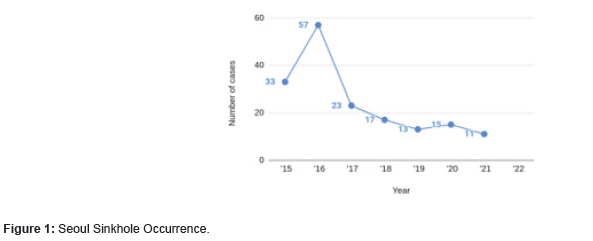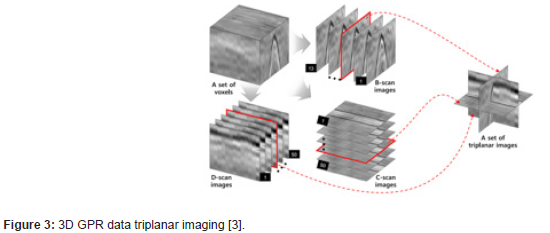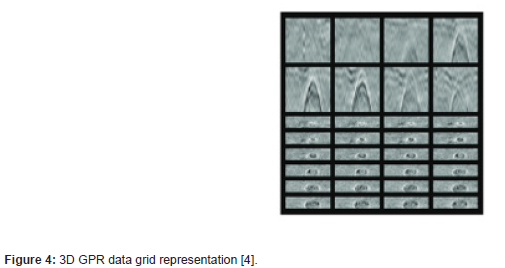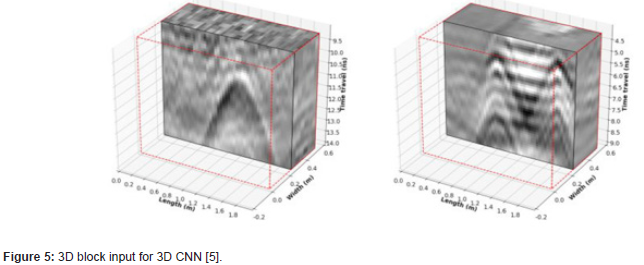 Case Report
Case Report
Sinkhole Prevention Program in Seoul, Korea
Ryan Lee1 and Jong-Jae Lee2*
1Cate School, Carpinteria, CA, USA
2Sejong University, Seoul, Korea
Jong-Jae Lee, Department of Civil and Environmental Engineering, Sejong University, Seoul, Korea.
Received Date: December 20, 2022; Published Date: January 04, 2023
Case Report
In August 2014, a large sinkhole with a width of 2.5m, a depth of 5m, and a length of 8m was discovered in Seoul and was followed by an additional sinkhole with a width of 5-8m, a depth of 4-5m, and a length of 70m in the center of Seokchon underground driveway. The sinkhole accident occurred in the downtown area and almost led to significant casualties. About 70% of underground cavities in Korea are caused by defects in old pipelines, and the rest 30% is caused by ground water runoff during underground facility construction [1]. Considering that underground cavities are caused by various artificial factors such as poor underground facility construction, water leaks from sewage pipes, and changes in groundwater flow, big cities with extensive scale of underground facilities are constantly at such risk. To secure underground safety, the “Special Act on Underground Safety Management” has been enforced since January 18, 2018. This special law stipulates that a basic plan for underground safety management should be established and implemented by the ministry of land and transportation and local governments. Also, it is enforced that underground facility managing agencies should carry out regular safety inspection including underground cavity detection. Ground penetration radar (GPR) is commonly used inspection system for underground cavities. In response to the underground cavity accident in Seokchon underground driveway in 2014, Seoul City initiated sinkhole prevention program which is a cavity investigation and restoration project along with road pavement. They conducted GPR inspection of a total 13,049 km across Seoul and found and repaired 5,192 underground cavities. These efforts led to the drastic decrease in the number of sinkholes from 57 cases in 2016 to 11 cases in 2021 [2] (Figures 1, 2).


Recently, artificial intelligence (AI) has emerged to solve complex data classification and recognition problems due to its advantages of self-feature extraction, unsupervised learning, and non-destructive analysis abilities. An automated method based on deep learning using 3D GPR data has been developed to detect underground cavities. The method was experimentally validated using real GPR data obtained from urban roads in Seoul, Korea. The initial approach was to use triplanar imaging of 3D GPR data, an innovative method compared to the conventional 2D cavity detection methods of using hyperbolar patterns as shown in Figure 3. In this method, the central intersectional images of 3D data are used as input data for detection with AI [3]. Novel methods using 3D GPR data as a grid image [4] and 3D block data for 3D convolutional neural network (CNN) [5] have been studied with the same data from Seoul as shown in Figures 4 and 5. This research have shown promising results in terms of detection accuracy and computational cost (Figures 3-5).



To prevent sinkhole accidents, it is necessary to find as many hidden cavities as possible from underground and take preemptive measures. Sinkhole cases are decreasing through Seoul City’s comprehensive sinkhole prevention program. Seoul City, in addition, plans to invest 2.7 trillion won by 2023 to promote 10 tasks such as establishment of underground safety system as well as to conduct cavity investigations on 178 routes with a high risk of sinkhole, frequent management of old water and sewage pipes, and management of old heat transport pipes and electricity, communication, and gas pipes. AI assisted inspection system will further contribute for more economized and efficient management of underground cavity detection. With its assistance in the application of sinkhole prevention program, Seoul City will maintain to ensure the safety of civilians.
Acknowledgment
None.
Conflict of Interest
No conflict of interest.
References
- Han Y (2108) Proposal of the Development Direction on the Special Act on Underground Safety Management for Preparation of the Proactive Underground Safety Management System. Journal of the Korean geotechnical society 34(7): 17-27.
- https://opengov.seoul.go.kr/press/25263560
- Kim N, Kim S, An YK, Lee JJ (2019) Triplanar Imaging of 3-D GPR Data for Deep-Learning-Based Underground Object Detection, in IEEE Journal of Selected Topics in Applied Earth Observations and Remote Sensing 12(11): 4446-4456.
- Kim N, Kim S, An YK, Lee JJ (2021) A novel 3D GPR image arrangement for deep learning-based underground object classification, International Journal of Pavement Engineering 22(6): 740-751.
- Khudoyarov SH, Kim N, Lee JJ (2020) Three-dimensional convolutional neural network–based underground object classification using three-dimensional ground penetrating radar data. Structural Health Monitoring 19(6):1884-1893.






